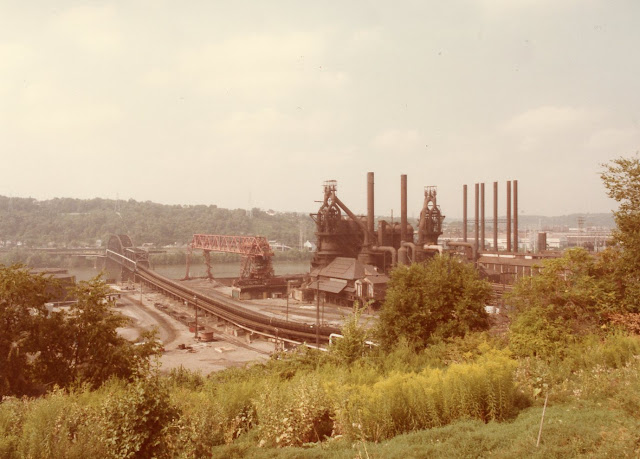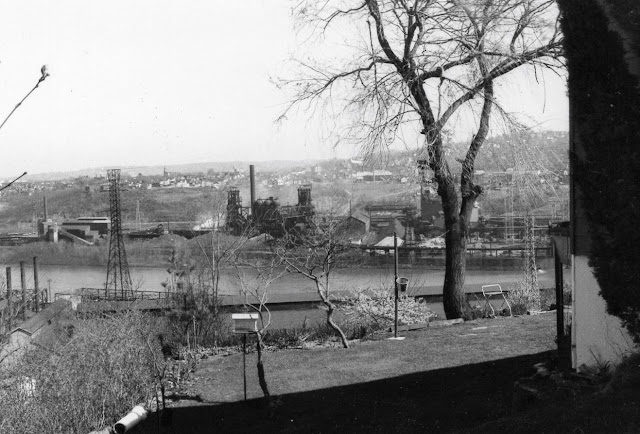(
Satellite)
The Carrie Furnaces operated from 1884-1982, and they shipped iron over the
hot-metal bridge to the
Homestead Works. Two of the furnaces, #6 and #7, have been preserved and you can tour them at the
Rivers of Steel.
 |
Dave Collins posted
Growing up in a 'steel town' was unique. My dad worked at Carrie Furnace in Rankin from the time he was discharged from the Army after serving in WWII until he retired in 1984... some 40 years. If you lived in any community in or around Pittsburgh, nine out of ten home's income was steel related. If you didn't work in a mill, you worked for a company that supported the mills... from machine shops to trucking companies. And small businesses like bars, restaurants and retail stores grew from the money generated by the epitome of the term 'blue collar'... steelworkers. |
 |
| Brandon Peck commented on a post |
"Just outside of Pittsburgh’s city limits along the Monongahela River stand the Carrie Blast Furnaces. They are two of the seven blast furnaces that were here, opened in 1907 and closed in 1978. The site is a national historic landmark managed by Rivers of Steel. Ron Baraff is their Director of Historic Resources and Facilities."
 |
Jackson-Township historical preservation posted
Evening view of the Carnegie Furnaces going full blast along the Monongahela River in Braddock, Allegheny County in 1915. |
 |
1 of 18 photos posted by Anthony Cominotti
Homestead Works and Carrie Furnaces |
 |
Adam Piscitelli posted
Aerial view of all 7 furnaces standing at Carrie taken during the flood of 1936. Furnace #5 was demolished a year later.— at Rivers of Steel: Carrie Blast Furnaces.
[It is the right side of this photo that has been preserved.] |
 |
Robbie Beck posted
Carrie Furnace Rankin. Pa |
 |
John J. Chapman posted
Carrie Blast Furnaces, U.S. Steel Homestead Steel Works, 1907 |
 |
Anthony Cominotti posted
Anybody know what the building on left behind flare stack at Carrie Furnace was?
Larry Marchek: Isn’t that the parking lot at the bottom of the photo? I finally recognize the Carrie I knew! Gary J Condon Sr.: Larry Marchek Yes it is, how many tires were stolen from that lot! Stephen Paterson: It was a powerhouse. Homestead had open hearths. If I remember correctly, they removed #5 furnace to put in the powerhouse. Russ Boyle: the 96 inch vertical boring mill in the big shop used 25 cycle power from Carrie. Bob Casselberry: The two big ducts say that's an old electrostatic precipitator. Dust traveling through the ducts got stuck onto a big charged grid and then washed into collecting tanks. Gary J Condon Sr.: I was a millwright for Power & Fuel and worked in that building. That is #3 powerhouse. It was built in 1941 and paid for by the US Government. It had two boilers that produced 600 Psi, 900-degree steam. It also had an Allis Chalmers steam generator that generated 25 cycle power. Also two turbo blowers that provided wind to the blast furnaces. After the blast furnaces were banked the powerhouse ran from 1981 thru 1984. John Blick: Carrie had a powerhouse. In 1979 I worked on an electronic precipitator. Part of USS grand plan to reduce pollution and save Mon-Valley works. Don’t think that worked. Gary J Condon Sr.: John Blick Yes John is right, two electrostatic precipitators were added in the late 1970's. [Comments indicate that the blast furnace we see is #6. #6 and #7 are the two that are extant. They were the oldest.] |
 |
Kenny Hall posted
Carrie furnaces of USS Corporation..Painting by howard Fogg |
.jpg) |
Adam Piscitelli posted
Carrie Furnace in the 50's. Furnaces 3&4 on the left, 1&2 in the middle and 6&7 on the right.
Everything in that image with the exception of the two furnaces on the extreme right has been demolished.
Jeffrey Berkosky: Was there a number 5? Adam Piscitelli: Yes. #5 was built in 1903, shut down in 1929, and demolished in 1937. |
Bob Clementi
posted two photos.
 |
1
Dave Brown: Carrie Fce.#3...#4 in back....Lead to the URR Rankin Bridge foreground...old bldgs... used to be a Wire Mill.. |
 |
| 2 |
 |
David Janusek posted
Not sure where exactly this photo was taken . . . And go
David Lawrence: Carrie Furnace, Rankin PA, by Pittsburgh Post Gazette photographer Paul Slantis, circa 1946-1956. |
 |
Trilby Busch posted
Another 1976 photo of Carrie Furnace taken from Whitaker, a bit downriver from the one with the wash on the line. Photo by G. Edward Busch. (Please credit.)
Gary J Condon Sr.: Right to left, #3 powerhouse (behind tree), AC powerhouse (still there), #6 furnace, stoves, #7 furnace, steam shed then sintered plant.
And #1&2 ore yard between #3 powerhouse ans AC powerhouse.
Edmund Joscak: Gary J Condon Sr. Just how many furnaces did Carrie have?
Jason Sessoms: Edmund Joscak when Carrie shutdown? I think 4....#3 #4 and #6 and #7.
Gary J Condon Sr.: Edmund Joscak when I started 5. #1, #3, #4, #6, & #7 |
 |
Michael Hower posted
"Torpedo" - Torpedo Car for carrying hot metal, Carrie Blast Furnace, former home of US Steel |
 |
Bob Ciminel posted
Homestead Works, 1954. Chalking it up!
Rick Rowlands: That isn't Homestead Works, that is Carrie Furnaces. That is the records board for a blast furnace where the charging sequence, wind rate, temperatures etc. are recorded. The board for Carrie 6 and 7 still exists. Not sure which furnaces this board is for though. |
 |
Adam Piscitelli posted
Rebuilding Number 4 at Carrie Furnace.
Kevin Gladysz: "Relining"...! |
The three historical photos posted by John Badertscher with the comment: "Carrie Blast Furnace In Rankin PA (right across the Monongahela River from Homestead and old Homestead Mill). You can still see it today and they will give tours."
 |
| 1 |
 |
| 2 |
 |
| 3 |
Anthony Cominotti
posted two photos with the comment: "comparison of Carrie Furnace rebuild."
Rick Rowlands: Basically the cast houses and furnace shells were the only components retained in the 1937 rebuild. Tops, stoves, gas cleaning equipment, hoist houses were all changed. Ore bridge was replaced in the 1950s.
 |
| 1 |
 |
| 2 |
 |
James Torgeson posted
A map of the Carrie Furnace site of the Homestead Works. Remaining structures are highlighted in yellow. (Sorry, the cell phone picture may not yield much detail.) |
 |
James Torgeson commented on his post
Here are the brief histories of the seven Carrie BFs. |
 |
| James commented on his post |
 |
| James Torgeson commented on his post |
 |
| James Torgeson commented on his post |
Bonus
The Pittsburgh area not only made steel, they used it.
Todd Branch
posted two images with the comment: "McClintic-Marshall Rankin Pa. Works."
 |
| 1 |
 |
| 2 |
 |
Ciao Pittsburgh posted
Pittsburgh steelworkers coming home after a long grueling day at the steel mill in 1939.
Don Drolet: And after that long day, they had that long trek up a very long and steep set of stairs to get home unless they were close to one of the inclines. No need for weight watchers back in those days!
Maureen Barrett: Don Drolet For sure! And, this is why we were not fat as kids! Also, our parents did not have snacks around like people do today. Plus, we ate dinner as a family around the dining room table, depending on which shift Dad was working.
Patricia Witt: Look at how they are dressed. My Dad kept a clean set of clothes to come home in. They had lockers and never wore their overalls outside of the mill. Gentleman everyone.
Bruce Welsh: Back when I worked in the Steel mill, in the late 70's those steps would have been the hardest part of the day.
Bea Smith Mielke: I walked up similar steps coming home from Carnegie high school, down the tracks a bit. We had excellent leg muscles!
Bob McDermott: In the 50s and 60s workers could support their families on their income alone. Send all their kids to college without lifelong debt. Take a nice vacation every summer. A family illness wouldn’t leave them swimming in medical bills. Have a comfortable retirement etc. The days when wages were enough to empower people.
Worked at J&L Steel in the southside for a summer. Remember clearly what was said at the safety presentation on my first day. “In 1909 a worker was killed on the job on average every other day”. Lord only knows how many were maimed. In those days the family saw no compensation for the
worker ( or the family ) killed or maimed. My great grandfather was killed in a steel mill accident.
Richard Stepusin: Looks like the men leaving work at the Rankin Pa "American Wire Mill Plant", walkway crosses over the B & O Tracks and ends on 2 nd St. Rankin @ the streetcar stop. I never saw my Grandfather one of theses men could be him.
|
 |
Adam Piscitelli posted
From the Carrie archives: The short lived #5 furnace. Built in 1903, blown out in 1929 and dismantled in 1938. |











.jpg)






















No comments:
Post a Comment